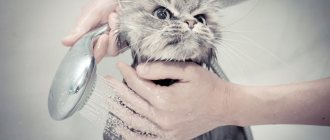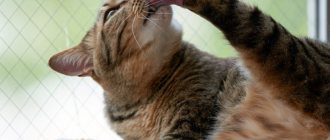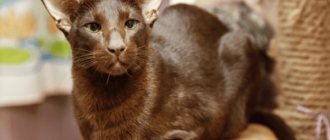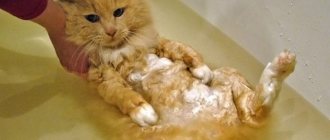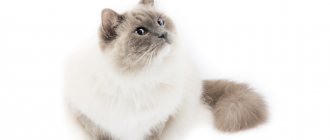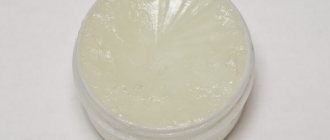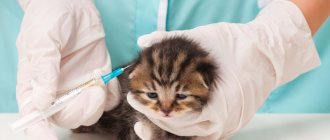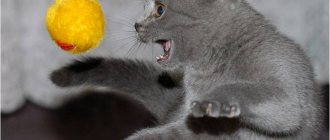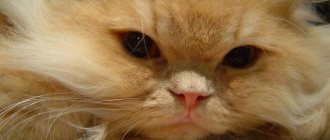What do you need to participate in the exhibition?
Any cat that meets the conditions of one of the registration organizations can take part in the exhibition.
Age
Usually, if a kitten has reached 3-4 months, he is gladly accepted as a candidate. But kittens that are younger than this age are accepted only with the kitten’s mother as part of the litter. There is no age limit for an animal to participate in an exhibition, but it is not recommended to take a cat over 10 years old to such events.
If you are going to use your pet for breeding, remember that in this case they will only be able to evaluate it from 10 months. Until this age, a cat can participate in exhibitions, however, after 10 months, any pet that is recognized as suitable for participation in breeding is presented to the exhibition again.
Health
It is very important that the cat is completely healthy:
- Vaccinated against rabies, panleukopenia, calicivirosis and rhinotracheitis no earlier than a year and no later than one month before the exhibition.
- Dewormed with a broad-spectrum drug.
- The cat should not be injured by people or other cats. An animal that shows a minor injury, such as a scratch, bite, or abrasion, may lose several precious points when judged by the experts. And if there are significant injuries, the pet may be completely removed from participation in the competition.
- The animal must not have congenital defects - strabismus, bald spots, blindness, cleft lip, etc.
- A pregnant cat is only assessed until it is noticeable in appearance - approximately 5 weeks.
- Nursing cats are also taken to exhibitions. However, noticeable signs of lactation can significantly reduce the score.
- Neutered and spayed cats can only take part in classes that are available to them.
So, if your cat meets all of the above requirements, think about whether the animal will be able to visit such crowded places. Often unsociable and shy cats, when surrounded by a crowd of unfamiliar people and animals, loud noise and strange smells, experience very severe stress. And, most likely, there is no point in wasting your time and money in this case. After all, if a contestant hisses or scratches an expert, he will be disqualified.
XI International Cat Show “Grand Prix Royal Canin”
If you are convinced that your cat is the future star, start collecting documents and preparing the cat for the exhibition. Now you must realize that you are taking on some responsibilities and financial costs.
Required documents
- Veterinary passport. Each animal, regardless of whether it is purebred or not, must have its own veterinary passport, which must contain records of all injections and treatments for parasites.
- Certificate of form No. 4. For the exhibition, you should issue a certificate of form No. 4, which is issued on the basis of a veterinary passport and a clinical examination of the cat - an assessment of the appearance of the animal.
Additional documents if you are planning to travel to an exhibition out of town
Certificate form No. 1. The certificate will indicate the sanitary and epidemiological situation in the area of your residence.
These certificates must be issued at a state veterinary clinic.
When issuing any certificate, keep in mind the fact that it is valid only for 3 days from the date of receipt.
Additional documents if you are planning to travel to an exhibition abroad
You need to obtain an international veterinary passport.
If your cat is purebred, you will need to have documents with you confirming this:
- contract of sale,
- kitten birth metric
- pedigree
Basically, such documents are drawn up and issued immediately after purchasing a purebred kitten.
For the first time, it is better to participate in an exhibition that is located near you.
The Supreme Cat Show is the world's largest cat show, held annually in Birmingham. 2010
Other little things
It is advisable to fill out the form and submit an application for participation at least a month before the opening. It is very important to fill out the form correctly: indicate the exact gender, age, breed, coat color, nickname, etc.
In case any questions arise, the telephone number and name of the administrator should be indicated on the first page of the form.
It is recommended to check the cost of a cat show in advance. Usually the amount ranges from 600 to 2200 rubles. depending on the rank of the event. You may need to pay the exhibitor fee in advance.
In addition to personal data in the form, you will need to select the appropriate exhibition class, which is divided depending on the exhibition system in which your pet will take part.
Secrets of care a week before the competition
When starting to actively prepare for an exhibition, do not expect to use the same means as you would at home. The competition places completely different, high demands on the animal’s condition. Always remember that you do not need to achieve a momentary result at any cost, but take a serious approach to the issue. After all, most exhibitions last two days, and the abundance of powders and gels on the first day will glue the wool together stronger than cement. You need to be especially careful with incompatible drugs - powder and oils, gels and lotions. In breeds where the volume and thickness of the coat are of particular importance, the cleanliness of the coat before the exhibition is of key importance. The cleaner it is, the better it holds volume. Therefore, a week before the competition, wash your pet.
The structure of a cat's fur is such that with prolonged use of oils, it becomes saturated with them and after bathing in regular shampoo it still looks greasy. To prepare for the exhibition, there is a special type of detergent - for deep cleaning. It is used if the cat has thick hair. Immediately after it, you should treat your hair with a structuring shampoo. But if your pet’s fur is a little “liquid,” structuring may squash it a little and the desired effect will be lost. Here, as a supplement, you can use tinting or, conversely, clarifying shampoos. But, again, their effect must be checked in advance. If the coat is hard, you need to use softening shampoos or conditioners.
Cat Show Systems
All cat exhibition systems are divided into 3 types:
- European
- American
- British
Each system differs in judging methods, show classes, titles and much more.
European system
The wcf system is one of the European ones, which is currently considered the most popular in Russia. It is known for the fact that its experts are relatively loyal to new breeds and quickly recognize them. In addition, according to the wcf system, the cat is accompanied by the owner throughout the entire exhibition, which, you see, is important for a pet. Score sheets and diplomas at such an event are issued only after the exhibition. European exhibition systems also include fife, ofa, farus, mfa, wacc.
American system
The American exhibition system is distinguished by the fact that experts do not evaluate cats on tables. There are rings where cats are described verbally. And instead of evaluation sheets, participants in such exhibitions are given ribbons called ribbons. According to the American version, systems such as tica, cfa, cff, icu, rui and wca work.
British system
The British system is not as popular as the European and American ones. There is only one system here - gccf, which evaluates cats sitting in cages.
Upon arrival at the place
The first step is to inform the secretariat that you have arrived. To do this you need to register. Take all the documents and get in line. The secretary will check the data and give you the exhibition catalog and two plates with the number. The catalog contains information about the participants and the cat show program. Check all the data: if an error is found, notify the secretary as soon as possible and fill out a special form, otherwise the resulting score will be invalid.
If it is a large international cat show, the boxes provided by the organizers may already be numbered, then all you have to do is find your place. If not, you can choose any table you like. It is advisable that this be a place close to the expert’s table, not in a draft, not under air conditioning. You can remove the cage and set up your own tent. Now it's time to go through veterinary control.
Take with you all the documents, the cat in a carrier and a disposable diaper, which you need to lay on the table before placing the cat on it. The veterinarian will examine your pet and, if everything is in order, will issue you a veterinary certificate. The doctor will not allow an animal to be examined that appears to be unhealthy, an aggressive, deaf or overly timid cat, or a pregnant or lactating pet. In addition, cats with the phalanges of their toes (claws) removed are not allowed for examination.
Now you can settle in. Place the cat in the tent, attach one of the plates with a number to the box (the second is attached to the owner’s chest), pour the cat a drink, and decorate the box. Do not go far from the tent: when the examination begins, the steward will call you personally or your number will be announced over the speakerphone.
Titles and exhibition classes
Traditionally, cats are included in one open class and 2-3 more at will. For purebred cats, the open class is characterized by breed. For example, Bengal, British, Scottish fold, Burmese and others. If the cat is not purebred, open classes are divided into pet colors - black, tabby, etc.
There is also a debutant class - for cats that are participating for the first time, or comic classes for outbreds (for example, “the cat with the longest tail”). It is better to apply to the maximum number of classes allowed to increase the chance of winning, especially since the cat will be able to get used to the new place.
For example, the wcf rules have developed 20 assessment classes and 5 age groups. To receive the title of champion, interchampion, etc., as well as to move from a low class to a high one, a cat must receive a certain number of diplomas in accordance with the exhibition class. And only on the basis of all these diplomas will the animal receive a title certificate as confirmation of the title title.
Exhibition of purebred cats
The main goal of the exhibition of outbred cats is to promote care and responsibility towards all domestic cats.
Outbred or even stray cats always participate in the exhibition on an equal basis with others and can just as deservedly receive awards and certificates. However, remember that desire alone is not enough to win the exhibition of a kitten you picked up on the street; you need to properly care for and train your pet.
Outbred cat show in Penza, 2015
Grooming
On the day of the exhibition they do grooming. The goal is to give the coat volume and shine, protect it from electrification and pollution, and make the pet appear in ideal form.
In the morning, the cat is combed against the grain, having previously been treated with an antistatic agent, exhibition foam or powder.
As a result, the animal’s fur should be soft to the touch and fall off gently.
Important! It must be remembered that excessive coloring and the use of powder on the animal will result in disqualification.
After the exhibition, it is necessary to bathe the cat again to wash off all the drugs from it.
Preparing a cat for an exhibition
The exhibition should be taken seriously, so it is better to plan everything carefully in advance.
List of required things
Prepare or purchase from a specialized store everything you need to participate:
- performance cage;
- a curtain with which you will hang the cage;
- cat litter;
- toilet and filler;
- a bowl for food and a separate one for water;
- food and water;
- disinfectant;
- toys;
- comb.
It is recommended to choose a cage made of metal with multi-colored inserts made of specially selected fabric. You can sew the curtain yourself using your cat's favorite fabric. She will be able to hide her pet from neighboring competitors and keep the cage warm.
Cat show in Moscow “Vozrozhdenie-2014”
Before hanging the curtain and laying down the rug, thoroughly clean the cage with a cat-friendly disinfectant.
Preparing the appearance
The cat should also be prepared for the exhibition. To receive an award, the animal must look and feel 100%!
If you have a long-haired pet, take care of its appearance six months before the start of the exhibition, but if you have a short-haired one, 3-4 months will be enough. You should bathe your cat at least twice a month, using a conditioner after bathing. Brush your cat as often as possible, gently clean its ears and trim its claws.
Providing food
It is not recommended to feed your pet before traveling. It is enough to feed him the day before the exhibition. You can feed your cat upon arrival, but it is best to do this after participating in the exhibition. But the animal should not need water, so constant access to it should be provided.
the washing up
Preparing for a cat show begins with bathing, but first you need to:
- comb with a sparse comb to rid the cover of dead hairs;
- trim claws;
- clean the inside of the ears;
- if the standard allows, pluck the hair on the ears from above;
- Place cotton balls in your ears.
When bathing, the cat should have support under its feet.
Washing takes place in 5 stages:
- Using products for deep cleaning of fur, thoroughly soap the animal. Particular attention is paid to the locations of the glands - behind the ears, under the tail, paws, pants. Light wool is bleached with special means, keeping them on the cover for 3-5 minutes. Rinse thoroughly, adding vinegar (4 tbsp per 10 liters) or citric acid (1 tsp per 1 liter).
- Another soaping with a degreasing shampoo is combined with combing. A wide-toothed metal comb will come in handy. Lather your hair with a sponge or toothbrush. Rinse the animal with plenty of water.
- Lathering with exhibition shampoo, special attention to the face and paws. Rinse.
- Lathering with tinted shampoo, which will add brightness and shine to the coat. Leave for 10-15 minutes and wash off.
- For volume, the wool is treated with conditioner and styling gel. Then you need to rinse the cat thoroughly
Cat Show Rules
In order for experts not to disqualify a cat, it must meet all the proper requirements and rules.
| General form | The pet must be clean and well-groomed - no grease on the tail and face, no dandruff, fleas and other parasites |
| Ears | Well cleaned |
| Eyes and area around the eyes | Clean, no discharge |
| Nose | No discharge |
| Transparent claw tips | Must be cut off |
| Area under the tail | Clean, no discharge |
Drying
First, the cat must be blotted with a towel, treated with an antistatic agent and dried with a hairdryer, while styling it so that the fur does not get tangled and gets volume.
- Paws. Using a brush, the wool is lifted from the bottom up, drying the base of the coat.
- Collar. The fur must be pulled back with a comb to make it straight and smooth.
- Muzzle.
- Back. Comb against the grain.
- Pants and belly. The wool is pulled down.
Light wool is powdered to avoid contamination, then the excess is blown out with a hairdryer.
It is recommended to drop Visine into the animal's eyes - this will relieve irritation.
How is the cat show going?
Traditionally, cat shows take place in several rings over 2-3 days. Most often they are organized in the cold season, when animal fur begins to grow and looks most attractive.
It is advisable to arrive at the exhibition at least an hour before the opening so that the cat can recover from the trip and get used to it a little. In addition, you will need to have time to show the animal to the veterinarian and find a comfortable place. If you are late for the examination, you may be disqualified.
Main stages of the exhibition
- Upon arrival, you must immediately go to the registration desk, give your name and present all the necessary documents. You will be given an exhibition catalog and a registration number under which you will participate. In the catalog, be sure to check the accuracy of the data in accordance with your documents.
- A veterinary control table is usually located not far from the registration desk. Let your cat out on the table only after treating it with a disinfectant! If your veterinarian won't do this, take care of it yourself or use a disposable diaper.
- After the cat has been examined, you will be given a ticket, which you must keep until the end of all days of the exhibition.
- Then you can go into the hall and choose a place that is comfortable for you and your pet. Set up a display cage here and place your things. Check the decoration of the cage: hang up the registration number, decorations, toys - whatever you have prepared. Before calling an expert, you can take a photo of your pet or chat with participants and guests of the exhibition.
- After the announcement of the start of the exhibition, exhibitor owners wait for their numbers. As soon as you hear your treasured numbers, go to the expert and put the cat on the table. You only need to hold your pet if it starts to run away or if an expert requires it.
- Give the expert the opportunity to evaluate all the advantages and disadvantages of your animal. It is not allowed to talk or distract the expert. Try to be calm and confident, because the cat will sense your mood.
- At the end of the examination, you may be called back to the table for comparison if any pet is similar to yours. Next, the expert will fill out an evaluation sheet, which will be given to you along with your diploma after the entire event.
Cat show in Moscow “Beaumonde cats 2014”
The winners of the exhibition receive various souvenirs and sometimes substantial sums of money. But the most important thing is that participation in the exhibition will give you the opportunity to once again be convinced that your cat is the best, regardless of whether she receives high marks or not!
Rings
The WCF ring can be called the entertaining part of the program. If during the examination the owner and the judge are away from the visitors of the exhibition, then during the WCF-ring everyone can be present. The judging is open, the expert loudly (often into a microphone) describes the cat, noting its advantages and disadvantages. Any cat that has passed the examination can take part. There are only three classes: kittens up to 10 months, adult cats and castrati. There is no division into breeds, colors, coat type, gender. Ratings at a cat show according to the ring system are the places that animals occupy. The expert selects the 10 best cats in the class, then awards each a place from 10 to 1. The winners are awarded prizes, cups and rosettes in front of the exhibition guests - this is excellent advertising for the cattery or individual manufacturer.

